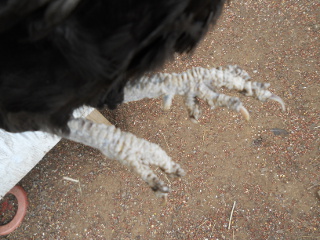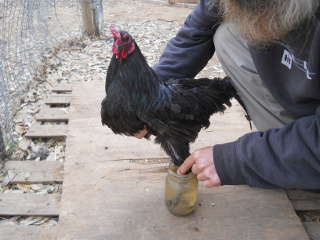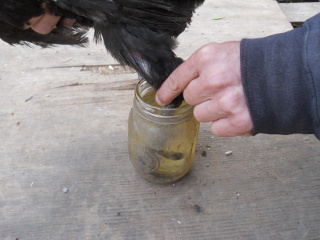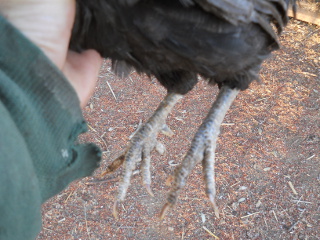Some time ago it was evident that one of our newer roosters was having some trouble walking — it would almost goose step. I noticed that its legs had developed a white crust on them, but thought that it was perhaps just a genetic defect or something. I picked off one of the crusties on the leg, and it looked like moist skin, like when a layer of human skin is removed. I wondered what was going on, but at the time, I just let it go. Then, over time, several of our chickens seemed to start getting the same crust on their legs or their scales started to look and feel “odd,” and I noticed that some of them were starting to have trouble walking, even some preferring not to do much of it.
Ok, something appeared to be wrong; and at that point, I figured I’d better investigate.
Here is a picture of the rooster’s legs:
In searching the Internet, and after finally working out a helpful search term, and after viewing several images, I discovered what I believed to be the culprit: scaly leg. This is apparently caused by a mite that burrows into the legs and causes the scales to protrude or that white crust I was seeing, and can in the end cause lameness. Wow! I was then glad I finally looked into it, although I felt badly for that rooster because I hadn’t researched it earlier.
And so, after further investigation, the simplest way I found to remedy this situation is to get some cheap cooking oil (not motor oil, because of the potential toxicity) and dip each leg in it for a couple of seconds (from an off off-gird standpoint, I assume we could probably use lard, but we just bought the oil instead rather than use up any lard now). This was supposed to be done for at least several days, and needed to be done to all infected birds, as the mite apparently spreads from bird to bird.
What I ended up doing was dipping each bird’s legs at night for about four days in a row, and then switched to every other day for about another week, and a couple more times at three days apart. Because we had so many to do, when I was dipping them every other day, I started alternating days with part of the flock. I used a pint jar so I didn’t have to have a lot of oil used at one time. It took a day or two to get the hang of not allowing the chicken to spill the oil, which I did by also holding the jar with the dipping hand.
Here I am dipping that rooster’s legs:
And sure enough, a few weeks later, apparently the mites died, and their legs began to heal. And here is that original rooster:
Nice!
Well, that little therapy appeared to work really well; and since then, it looks like the other chickens have had similar results.
We are thankful to the Lord for allowing us to fairly easily help the chickens, and we are grateful to Him for Him granting the healing that He did.
— David




Save your wood ashes for the chickens to dust bathe in. That can really help keep future issues at bay.
This post made me think about something that I hadn't thought about before. I am genuinely grateful to the Lord for the internet and the technology that allows it. Do you remember how frustrating these situations and others could be twenty five or thirty years ago without the ability to go online for information?
Hi Steve,
Very interesting…hadn't heard of it…looked it up, and it certainly appears to be a helpful approach. Thanks much for the info!
Hi Michael,
The Internet can be helpful, and the Lord has used it I know to benefit us, although He didn't need it and IMO despite itself; and personally, I prefer physical books, and I would have preferred to have grown up with or around people who had agrarian knowledge like this. 🙂
— David
Thank you for posting this. We had some bantams given to us as the previous owners coop was too crowded. Unbeknownst to us, their legs were affected and two had deformed toes (one of those was even missing a toe or two). We thought maybe it was just a skin ailment caused by acidic conditions and that it would clear up in more sanitary conditions. (I didn't have a clue as to how or what to even look up.) Unfortunately, they got sick and died due to our cold weather. (When it gets -60F, it's hard to keep anything warm!) So, we didn't get a chance really to try to fix it as they were only with us a total of 4 months. Now that I see this, I know *exactly* what they had. Again, thanks for sharing what you learned!
Hi athomeinalaska,
Hopefully you won't have the problem again; but if you do, hopefully this and/or the wood ashes will help.
— David
This is awesome! I am going to try it on my birds. 🙂
Hi Chicken Man,
Hope it works for you!
— David